|
Printables |
PowerPoints |
Online exercises |
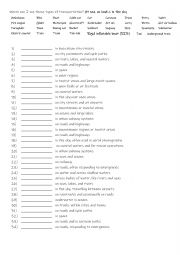
|
A2 + B1+ 34 types of transportation and where you can see them
Students match the type of transportation to the correct definition and place where they can be found. There are some new types such as Segway, Drone and Electric scooter etc. Answers on page 2.
Level: intermediate
Age: 8-100
Type: worksheet
Downloads: 118
|
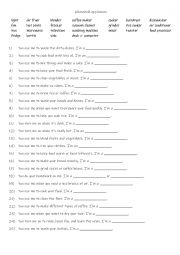
|
A2-B1 Household appliances
Students match the household appliances to their definition. Some new appliances such as air fryer and rice cooker. Answers on page 2.
Level: intermediate
Age: 8-100
Type:
Downloads: 118
|
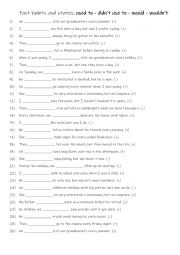
|
B1-B2 Past habits and states - used to - didn�t use to - would - wouldn�t practise
Students complete the sentences with the correct form of the verb using (+) for positive and (-) for negative verb constructions. Obviously, would cannot be used with state verbs, but can and should be used to contrast the past instead of just using used to. A selection of possible answers on page 2.
Level: intermediate
Age: 9-100
Type: worksheet
Downloads: 118
|
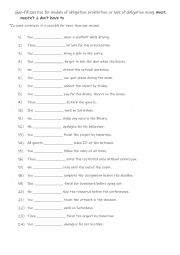
|
A2-B1 Gap-fill exercise for modals of obligation, prohibition, or lack of obligation using
Students familiarise themselves with the 3 modal verbs and their uses. They then read the sentences to see which modal verb is required to complete the gap-fill. Each modal is used 8 times. Answers on page 2.
Level: intermediate
Age: 9-100
Type:
Downloads: 118
|
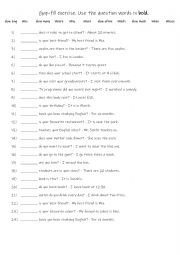
|
A1+ A2 Gap-fill exercise. Use the question words in bold.
Students familiarise themselves with the 11 question words in bold. Then they read the sentences and answer to the sentences to work out which question word is needed to complete the question. Answers on page 2.
Level: elementary
Age: 8-100
Type:
Downloads: 118
|
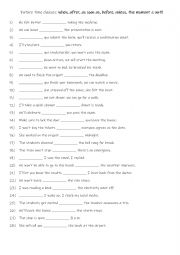
|
A2+-B1+ Future time - clauses: when, after, as soon as, before, unless, the moment & until
Students familiarise themselves with the 7 time clauses:Future time clauses: when, after, as soon as, before, unless, the moment & until. Then they read the sentences to see which adverb is required to complete the gap-fill. Each adverb is used 4 times. Answers on page 2.
Level: intermediate
Age: 9-100
Type:
Downloads: 118
|
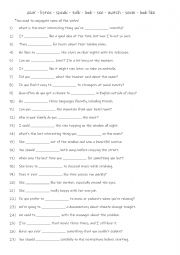
|
B1-B2 Confusing words Hear - listen - speak - talk - look - see - watch - seem - look like
Students familiarise themselves with the 10 verbs to see what is the difference in meaning. Then they read the sentences to see which verb is needed to complete the gap-fill. The students need to conjugate some of the verbs. Answers on page 2.
Level: intermediate
Age: 8-100
Type: worksheet
Downloads: 118
|
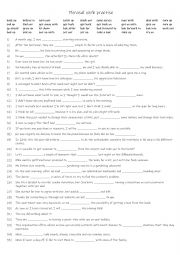
|
B1-B2 27 Phrasal verbs
Students need to familiarise themselves with the 27 phrasal verbs to understand the meanings of each one. Then they read the sentences to see which phrasal verb is needed to complete the sentences. Answers on page 2.
Level: intermediate
Age: 10-100
Type:
Downloads: 118
|
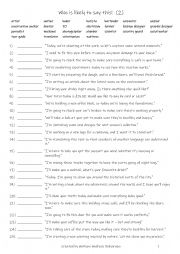
|
A2-B1 Who is likely to say this! (2)
Learning vocabulary for professions like journalist, mechanic. photographer and plumber is valuable because it helps people identify roles, understand career-specific responsibilities, and communicate effectively in different situations. Recognising job titles and what each profession involves supports clearer communication in daily life and improv...
Level: intermediate
Age: 8-100
Type:
Downloads: 118
|
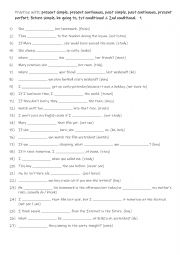
|
B1-B2 Practise with: present simple, present continuous, past simple, past continuous, present perfect, future simple, be going to, 1st conditional & 2nd conditional. 1
Practising these tenses allows B1-B2 students to speak confidently about everyday situations, past events, future plans, and hypothetical scenarios. It improves their ability to communicate with precision, enhances fluency, and prepares them for more advanced grammar. Mastery of these structures supports clearer expression of ideas and better under...
Level: intermediate
Age: 8-100
Type:
Downloads: 118
|
|
|
|
|












